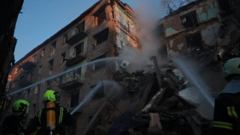The protests in Kenya, marking a year since prior unrest, saw significant violence as demonstrators faced police retaliation. With chants for President Ruto's resignation, the government is under scrutiny for its handling of dissent and public unrest, drawing attention to the growing frustration among citizens.
Escalating Tensions: Protests Erupt in Kenya Amidst Calls for Government Accountability

Escalating Tensions: Protests Erupt in Kenya Amidst Calls for Government Accountability
Nationwide demonstrations in Kenya result in clashes with police, leaving at least eight deceased and hundreds injured as citizens demand change from President Ruto's administration.
Kenya has witnessed a surge in protests marked by violence and civil unrest, with at least eight fatalities and approximately 400 injuries reported as thousands voiced their opposition to President William Ruto's administration. The demonstrations erupted in several cities, notably Nairobi, on the anniversary of similar anti-government protests in 2024.
Protesters chanted demands for Ruto’s removal and peacefully displayed branches, signifying peaceful opposition. Despite government efforts to suppress coverage of the protests, a High Court decision allowed media access, highlighting tensions between the administration and freedom of expression.
In his response to the unrest, President Ruto, while attending a burial ceremony in Kilifi, appealed for peace, underscoring Kenya's responsibility to maintain stability. His absence from State House raised eyebrows, especially as demonstrators showed intent to reach his residence before being met with barricades and heavy police presence.
According to a joint statement from several organizations, including the Kenya Medical Association and the Police Reforms Working Group, the number of casualties is stark, with 83 individuals needing specialized medical care and injuries suffered by both protesters and police. Amnesty Kenya reported a potentially higher death toll, reflecting deepening concerns about the government's use of force.
One protester, Amina Mude, articulated a wish for government accountability and better conditions for future generations, mirroring the sentiments of many Kenyans frustrated with the current trajectory of the nation. Scenes from Nairobi depicted the chaos, with tear gas clouds forcing demonstrators into retreat and the somber reminder of past fatalities evident in memorials around parliament.
As the country grapples with these protests, the situation raises questions about governance, civil rights, and the state's handling of dissent, emphasizing the need for dialogue and constructive change amidst the growing unrest.





















